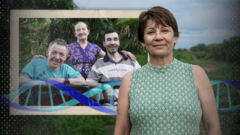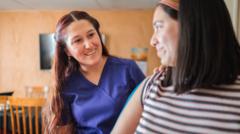In Serrinha dos Pintos, a small town in northeastern Brazil, residents grappled with a mysterious condition that caused many children to lose basic mobility. Geneticist Silvana Santos arrived over two decades ago, identifying the disorder as Spoan syndrome and uncovering its genetic links rooted in family intermarriages. Her groundbreaking work brought awareness and crucial support to the affected families, fostering a new generation of understanding and hope.
Unraveling Spoan Syndrome: A Genetic Journey in Serrinha dos Pintos

Unraveling Spoan Syndrome: A Genetic Journey in Serrinha dos Pintos
Discover how a remote Brazilian town confronted a rare genetic disorder affecting its children, thanks to the relentless dedication of a geneticist.
In the tranquil town of Serrinha dos Pintos, located in northeastern Brazil, a curious phenomenon captivated a community long plagued by unexplained ailments among its children. Here, a little-known genetic condition, Spoan syndrome, had kept families seeking answers for years until the arrival of geneticist Silvana Santos more than twenty years ago.
This humble town, inhabited by fewer than 5,000 residents, became the unexpected focal point of Santos's pivotal research, leading to the first documented description of Spoan syndrome worldwide. This rare condition, borne from a genetic mutation, affects the nervous system and is inherited only when both parents carry the altered gene. Before Santos's diligent work, no one in Serrinha understood the startling correlation between their family ties and the health issues affecting their children.
Santos, who has since become recognized among the BBC's 100 most influential women in 2024, brought clarity and support to those suffering. After meeting a local family with children exhibiting grievous symptoms, she devoted herself to uncovering the genetic threads binding their plight. As she and her team identified additional cases globally, they opened the doors to new discussions surrounding genetics and its familial implications.
The intricate social fabric of Serrinha was evident. Many couples were related, creating a fertile ground for genetic mutations to manifest in their offspring. With statistics indicating that about 30% of couples in Serrinha share bloodlines, conservatively scaling the risk of passing on rare genetic disorders arose as a pressing concern. While geneticists assert the healthy birthrate among cousins is appreciable, risks are elevated, with the likelihood of genetic disorders climbing to 5-6% for cousin pairings, as opposed to just 2-3% for unrelated couples.
Santos's extensive fieldwork, which included collecting DNA samples and sharing coffee with local families, propelled her forward in her quest. After years of meticulous study, her landmark discovery in 2005 highlighted Spoan's presence in the Brazilian hinterland, revealing an ancient genetic mutation likely originating with early European settlers.
Despite having no known cure for Spoan, local lives have transformed; wheelchairs have improved the quality of life for many, offering independence where there was none. Santos's influence extended beyond diagnosis; she has helped reshape how the community perceives disabilities, slowly removing stigmas attached to terms like "cripple."
Today, the town fosters a blend of hereditary connections and burgeoning genetic literacy, spurred on by Santos's commitment to local education around genetics. The next phase of her work involves screening thousands of couples with the Ministry of Health, aimed at addressing the risks of hereditary illnesses while honoring the cultural dynamics within Serrinha.
As Santos visits Serrinha again, she is greeted almost like a family member. The once-struggling families now embrace an empowering spirit, united in their journey to understand and navigate the unique challenges of their shared ancestry through the lens of modern genetics.








